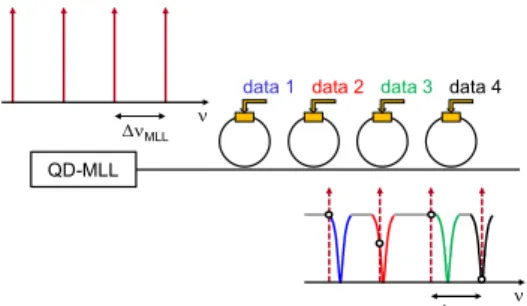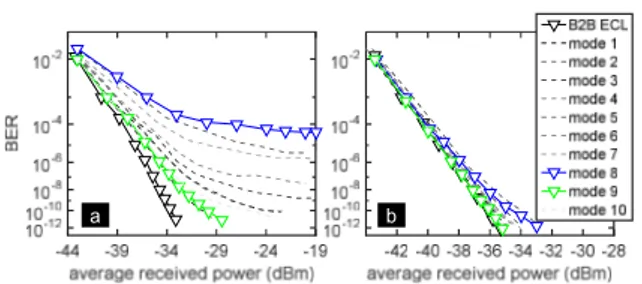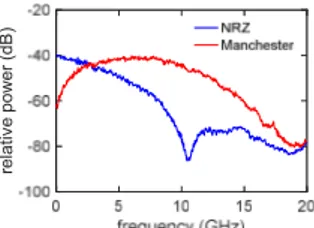HAL Id: hal-01461201
https://hal.archives-ouvertes.fr/hal-01461201
Submitted on 7 Feb 2017
HAL is a multi-disciplinary open access
archive for the deposit and dissemination of
sci-entific research documents, whether they are
pub-lished or not. The documents may come from
teaching and research institutions in France or
abroad, or from public or private research centers.
L’archive ouverte pluridisciplinaire HAL, est
destinée au dépôt et à la diffusion de documents
scientifiques de niveau recherche, publiés ou non,
émanant des établissements d’enseignement et de
recherche français ou étrangers, des laboratoires
publics ou privés.
Mitigation of mode partition noise in quantum-dash
Fabry- Perot mode-locked lasers using Manchester
encoding
Mohamed Chaibi, Laurent Bramerie, Sébastien Lobo, Christophe Peucheret
To cite this version:
Mohamed Chaibi, Laurent Bramerie, Sébastien Lobo, Christophe Peucheret. Mitigation of mode
partition noise in quantum-dash Fabry- Perot mode-locked lasers using Manchester encoding. 42nd
European Conference on Optical Communication (ECOC 2016), Sep 2016, Duesseldorf, Germany.
�hal-01461201�
Mitigation of Mode Partition Noise in Quantum-Dash
Fabry-Perot Mode-Locked Lasers using Manchester Encoding
Mohamed Essghair Chaibi, Laurent Bramerie, Sébastien Lobo, Christophe Peucheret FOTON Laboratory, CNRS UMR 6082, University of Rennes 1, ENSSAT, 22300 Lannion, France
chaibi@enssat.fr
Abstract The use of Manchester encoding with balanced detection is proposed in order to overcome the mode partition noise (MPN) limit of quantum-dash mode-locked lasers used as multi wavelength sources. Successful MPN mitigation is demonstrated for a 10-mode laser at 10 Gbit/s.
Introduction
Multi-wavelength sources are highly attractive in the context of short-reach access and data-centre networks since they enable the generation of an entire comb of wavelength division multiplexed (WDM) channels with equal frequency spacing in a single device. Such sources could advantageously replace full arrays of single-mode lasers in a cost effective way and would moreover reduce operational cost by removing the need for line-by-line frequency control.
Quantum-dot or quantum-dash (QD) mode-locked lasers (MLLs)1,2 are highly compact and
have been successfully used as multi-wavelength sources in a number of transmission experiments3,4. They furthermore have the
potential to be heterogeneously integrated on the silicon platform through wafer bonding techniques in order to implement fully integrated WDM transmitters. One well-known limitation of such sources, however, is the increase of the relative intensity noise (RIN) of the filtered comb lines due to the effect of mode partition noise (MPN). A powerful MPN mitigation technique consists in amplifying the filtered lines with a saturated semiconductor optical amplifier (SOA) in order to filter the low frequency part of the RIN spectrum that is enhanced due to the effect of MPN5,6. However, this technique can only be
applied on the individual filtered comb lines after they have been demultiplexed and before modulation is applied. It is therefore not compatible with serial modulator architectures that have been recently proposed7,8, and whose
main benefit is not to require demultiplexing of the comb lines at the transmitter in order to perform modulation.
In this paper, we demonstrate how this issue can be circumvented by employing Manchester encoding in conjunction with balanced detection. The sensitivity to MPN of a 10-channel QD-MLL source is shown to be significantly reduced in a 10-Gbit/s experiment, resulting in improved receiver sensitivity or the suppression of MPN-induced bit-error-ratio floors down to 10-9.
Fig. 1: Serial multi-wavelength transmitter based on a QD-MLL and micro-ring modulators.
Principle of the technique
A transmitter architecture relying on a QD-MLL laser followed by a serial array of micro-ring resonator (MRR) modulators7,8 is schematically
represented in Fig. 1. Such a structure has the potential of being heterogeneously integrated on the silicon platform. The resonance of each MRR is tuned so that it only modifies the intensity of a single line of the frequency comb generated in the QD-MLL upon detuning due to the application of a modulating signal. The main benefit of this architecture is that the modulation operation does not require wavelength de-multiplexing and re-de-multiplexing. However, since the individual lines are not accessible prior to modulation, the use of a saturated SOA for RIN mitigation cannot be applied with this scheme. New MPN mitigation techniques therefore need to be found.
The use of balanced detection is known to be able to reduce the impact of RIN in analogue links9. However, such a detection scheme is not
compatible with the simple non-return-to-zero (NRZ) intensity modulation format to be applied in cost-effective short reach digital systems. On the other hand, Manchester line coding, in which the binary data is encoded in low-to-high or high-to-low transitions within the bit slot is fully compatible with intensity modulation and balanced direct detection10. It also reduces the
overlap between the modulation spectral content and the low-frequency region in which the RIN is enhanced due to MPN, albeit at the expense of a doubled modulation bandwidth. In the
QD-MLL
data 1 data 2 data 3 data 4
MLL
MLL
following, we demonstrate the benefit of Manchester encoding with balanced detection for MPN mitigation in a proof-of-concept experiment.
Fig. 2: Experimental set-up.
Experimental set-up
The experimental set-up is represented in Fig. 2. A QD-MLL6 biased with a current of 150 mA,
generates the frequency comb with 100 GHz channel spacing shown in Fig. 3(a). In the following, the ten consecutive comb lines presenting the highest signal-to-noise ratios will be exploited as a WDM source. The impact of MPN is illustrated in Fig. 3(b), where the RIN spectra measured following direct detection of all the laser modes, as well after individual detection of a single mode after bandpass filtering (worst case mode 8 & good case mode 9) are represented. The RIN is also compared to that of a reference single-mode external cavity laser (ECL) used later in the experiment. It is clear that filtering the modes results in a significant increase of the RIN, especially in the low-frequency part of the spectrum.
Fig. 3: (a) QD-MLL optical spectrum for a bias current of 150 mA. (b) Measured RIN for the joint detection of all
QD-MLL modes, after filtering of modes 8 or 9, and for the reference case of an external cavity laser.
The frequency comb is first amplified by an erbium-doped fibre amplifier (EDFA). The comb lines are then individually filtered one at a time by an optical bandpass filter (OBPF) before being intensity-modulated at 10 Gbit/s in a Mach-Zehnder modulator (MZM) using either the NRZ or Manchester line code. The signal is finally detected in a preamplified receiver before bit-error-ratio (BER) measurement. For NRZ coding, a standard 10-Gbit/s receiver is used, while a balanced detection scheme10 making
use of a pair of 30-GHz photodiodes followed by a clock and data recovery (CDR) module and a D-flip-flop is employed in the Manchester case.
A pseudo-random binary sequence (PRBS) length of 231-1 is employed throughout this work.
Results and discussion
The eye diagrams of the NRZ signal obtained when an ECL is substituted to the QD-MLL source as well as of a filtered comb line (mode 8) are shown in Fig. 4(a) and (b) respectively. The impact of MPN is clearly visible in the latter case. The corresponding eye diagrams obtained with Manchester coding are also represented in Fig. 4(c) and (d). Note that both NRZ and Manchester eye diagrams are monitored with the same single photodiode.
Fig. 4: Eye diagrams of the NRZ signal obtained from (a) a reference ECL or (b) the filtered QD-MLL. (c) and (d): corresponding eye diagrams with Manchester coding.
Fig. 5: BER curves for (a) NRZ and (b) Manchester coding.
The BER curves obtained for the filtered modes as well as for the reference ECL are represented in Fig. 5(a) and (b) for NRZ and Manchester coding, respectively. A large dispersion of the BER performance can be observed in the NRZ case, with the occurrence of floors for BER values as high as 10-4 for the
worst-case mode (#8). In contrast, the BER performance is significantly improved for all modes when Manchester coding is employed and the worst case BER floor now appears below 10-9. The improved overall sensitivity in
the case of Manchester coding, as can be seen from the ECL reference case, stems from the use of balanced detection.
In order to clarify the origin of the performance improvement, the measured BERs of Manchester line coding are compared in Fig. 6 for both balanced (BD) and single-ended detection (SD; in a 30-GHz photodiode) to that of NRZ line coding in the ECL reference case as well as for the filtered mode #8. The benefit of balanced detection is clearly visible in the reference case since it provides a 3.2 dB better
T/2 CDR+ DFF QD-MLL BER BER NRZ / Manchester RIN meas. EDFA EDFA OBPF OBPF MZM Manchester receiver NRZ 1 2 3 4 5 6 7 8 9 10 a b a b
Fig. 6: Comparison of the BER performance for single-ended and balanced detection Manchester coding, as well as NRZ coding in the reference ECL case and for a filtered
QD-MLL mode.
Fig. 7: Comparison of the measured RF spectra of NRZ and Manchester line codes at 10 Gbit/s.
sensitivity (at a BER of 10-9) for Manchester
compared to NRZ, while Manchester encoding suffers from a 3.3 dB power penalty in the single-ended detection case. In the presence of MPN (filtered mode 8), the introduction of Manchester encoding with single-ended detection is not sufficient to provide enhanced performance compared to NRZ. It therefore appears that the use of balanced detection is responsible for the performance improvement of Manchester with respect to NRZ.
An expected benefit of Manchester coding would be the fact that its spectral content is shifted away from the low frequency region, where the RIN is particularly enhanced by MPN, as shown in the measured radio-frequency (RF) spectra in Fig. 7. This spectral shift has already been exploited, for instance in the context of orthogonal modulation labelling11, as well as for
mitigation of Rayleigh noise in bidirectional links12. It is speculated that this frequency shift
could also contribute to the performance enhancement provided by the use of Manchester encoding, even though this is not visible in our demonstration due to the relatively high level of RIN of the filtered comb lines in the high-frequency region. A higher RIN power would thus be integrated in the receiver bandwidth in the high-frequency region in the case of Manchester than for NRZ, due to the higher bandwidth requirement of the former coding scheme.
Conclusions
The use of Manchester encoding in conjunction with balanced detection has been shown to be
an effective method to overcome the MPN-induced limitation in serially modulated WDM sources making use of QD-MLLs. A clear performance improvement was experimentally demonstrated at 10 Gbit/s in a 10-channel source, leading to BER enhancement and the reduction of BER floors to sub-10-9 levels.
Acknowledgements
This work was supported by the European Commission’s 7th Framework Programme through the
SEQUOIA project (grant agreement no. 619626). LPN and III-V Lab. are acknowledged for providing the QD-MLL developed in the framework of the TELDOT project supported by the French National Research Agency (ANR 2009-VERS-12).
References
[1] F. Lelarge et al., “Recent advances on InAs/InP quantum dash based semiconductor lasers and optical amplifiers operating at 1.55 m,” IEEE J. Sel. Topics Quantum Electron., Vol. 13, no. 1, p. 111 (2007). [2] V. Vujicic et al., “Quantum dash mode-locked lasers for
data centre applications,” IEEE J. Sel. Topics Quantum Electron., Vol. 21, no. 6, p. 1101508 (2015).
[3] Y. Ben M’Sallem et al., “Quantum-dash mode-locked laser as a source for 56 Gb/s DQPSK modulation in WDM multicast applications,” IEEE Photon. Technol. Lett., Vol. 23, no. 7, p. 453 (2011).
[4] J. Pfeifle et al., “Coherent terabit communications using a quantum-dash mode-locked laser and self-homodyne detection,” Proc. OFC, W2A.19. Los Angeles (2015). [5] K. Sato and H. Toba, “Reduction of mode partition noise
by using semiconductor optical amplifiers,” IEEE J. Select. Topics Quantum Electron, Vol. 7, no. 2, p. 328 (2001).
[6] M. Gay et al., “Single quantum dash mode-locked laser as a comb-generator in four-channel 112 Gbit/s WDM transmission,” Proc. OFC, Tu2H.5, San Francisco (2014).
[7] C.-H. Chen et al., “A comb laser-driven DWDM silicon photonic transmitter based on microring modulators,” Opt. Express, Vol. 23, no. 16, p. 21541 (2015).
[8] Q. Xu et al., “Cascaded silicon micro-ring modulators for WDM optical interconnection,” Opt. Express, Vol. 14, no. 20, p. 9431 (2006).
[9] A. Joshi et al., “Balanced photoreceivers for analog and digital fiber optic communications,” Proc. SPIE, 5814 (2005).
[10] Y. Yamada et al., “Tolerance for optical coherent crosstalk of a novel Manchester-code receiver,” ECOC Vol. 1, p. 61, Madrid (1998).
[11] J. Zhang et al., “Performance of Manchester-coded payload in an optical FSK labeling scheme,” IEEE Photon. Technol. Lett., Vol. 15, no. 8, p. 1174 (2003). [12] Z. Liu et al., “Rayleigh noise mitigated 70-km-reach
bi-directional WDM-PON with 10-Gb/s directly modulated Manchester-duobinary as downstream signal,” Proc. OFC, OW1B.1 (2012). BE R re la tiv e po we r ( dB )


